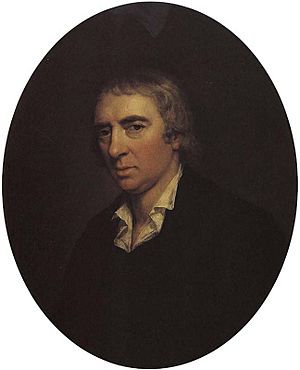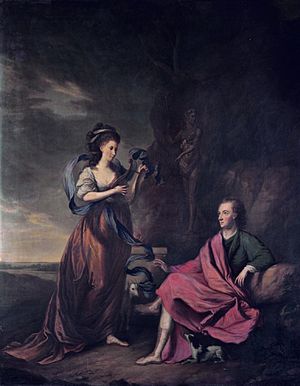Arthur Wolfe, 1st Viscount Kilwarden facts for kids
Quick facts for kids
The Viscount Kilwarden
|
|
|---|---|

Portrait by Hugh Douglas Hamilton
|
|
| Lord Chief Justice of the King's Bench in Ireland | |
| In office 3 July 1798 – 23 July 1803 |
|
| Preceded by | Lord Clonmell |
| Succeeded by | William Downes |
| Member of Parliament for Dublin City | |
| In office January 1798 – July 1798 Serving with John Claudius Beresford
|
|
| Preceded by | Lord Henry FitzGerald |
| Succeeded by | George Ogle |
| Personal details | |
| Born | 19 January 1739 Forenaughts House, Naas, County Kildare, Kingdom of Ireland |
| Died | 23 July 1803 (aged 64) Dublin, United Kingdom of Great Britain & Ireland |
| Spouse | Anne Ruxton |
| Residences | 5 Leinster Street (City residence), Newlands House |
| Alma mater | Trinity College Dublin |
Arthur Wolfe, 1st Viscount Kilwarden (born January 19, 1739 – died July 23, 1803) was an important Irish judge and politician. He held the high position of Lord Chief Justice of Ireland. Sadly, he was killed during a rebellion in Ireland in 1803.
Contents
Early Life and Family

Arthur Wolfe was born in a place called Forenaughts House, near Naas in Ireland. He was one of nine sons born to John Wolfe and Mary Philpot. His mother, Mary, was the only child of a successful merchant from Dublin. One of Arthur's brothers, Peter, was a local sheriff. His cousin, Theobald, was the father of the famous poet Charles Wolfe.
Arthur Wolfe's Career
Arthur Wolfe studied at Trinity College Dublin, which is a well-known university. He also studied law in London. In 1766, he became a lawyer in Ireland. Three years later, in 1769, he married Anne Ruxton. They had four children: John, Arthur, Mariana, and Elizabeth. Arthur Wolfe became a very successful lawyer.
Entering Politics
In 1783, Arthur Wolfe became a Member of Parliament (MP) for Coleraine. This meant he helped make laws for Ireland. He served as an MP until 1790.
In 1787, he was chosen to be the Solicitor-General for Ireland. This was a senior legal role, helping the government with legal matters. He then became an MP for Jamestown in 1790.
Attorney-General and Judge
Arthur Wolfe was made Attorney-General for Ireland in 1789. This was the chief legal advisor to the government. Even though he was part of the powerful Protestant ruling class, he was known for being fair. He believed in following the law strictly and often spoke out against unfair actions by the authorities. For example, he was involved in a legal case against William Drennan in 1792.
In 1795, a new leader for Ireland, Lord Fitzwilliam, wanted to replace Wolfe as Attorney-General. To make up for this, Arthur Wolfe's wife, Anne, was given the title of Baroness Kilwarden. However, Lord Fitzwilliam was soon recalled, and Arthur Wolfe kept his job.
In January 1798, he became an MP for both Dublin City and Ardfert. But he left Parliament when he was appointed Chief Justice of the Kings Bench for Ireland. This was a very important judge position. He was also given the title Baron Kilwarden on July 3, 1798.
Helping Wolfe Tone
Arthur Wolfe showed his fairness by helping Wolfe Tone, a leader of the United Irishmen who wanted Ireland to be independent. In 1795, Wolfe warned Tone and his friends to leave Ireland to avoid being arrested. Wolfe Tone's godfather was Arthur Wolfe's cousin. These efforts to help a political opponent were very unusual at the time.
After the Act of Union was passed, which joined Ireland and Great Britain, Arthur Wolfe supported it. He was then given an even higher title, Viscount Kilwarden, on December 29, 1800. In 1802, he was also made a leader at Trinity College Dublin.
Despite his help for Wolfe Tone, some people from the United Irishmen disliked Kilwarden. They remembered his involvement in the case of William Orr in 1797. Kilwarden worried about his safety after a rebellion failed. Some people believe his death in 1803 was revenge for Orr's case. Others think it was a mistake, and his attackers meant to target someone else. However, witnesses said Wolfe told his attackers his name, and they replied, "You're the one we want."
In 1802, he also oversaw a case involving Major Sirr, where it was shown how power was sometimes misused to stop rebellions.
Father Gahan's Case
In the same year, Kilwarden ordered a Catholic priest named Father William Gahan to be held for not answering questions in court. This happened during a case about a disputed will. Father Gahan refused to answer certain questions because it would break the secret of the confessional, which is a private conversation between a priest and someone confessing. At that time, the law did not recognize this secret as a reason to refuse to give evidence. Kilwarden might have felt some sympathy for Father Gahan, as the priest was released from prison after only a few days.
Death of Arthur Wolfe
During the 1803 rebellion, Kilwarden was in great danger. On the night of July 23, 1803, rebels from Kildare were approaching Dublin. Kilwarden decided to leave his home, Newlands House, with his daughter Elizabeth and his nephew, Richard Wolfe. He thought he would be safer among the crowds, so he told his driver to go through Thomas Street in the city center. However, this street was taken over by Robert Emmet's rebels.
When challenged, Kilwarden bravely stated his name and his important job. He was then pulled from his carriage and attacked. His nephew was also killed. Elizabeth, his daughter, was allowed to escape and ran to Dublin Castle to get help. When the rebels were stopped, Kilwarden was found still alive. He was taken to a nearby building, where he died shortly after. His last words were very famous. When a soldier called for his attackers to be killed, Kilwarden said, "Murder must be punished; but let no man suffer for my death, but on a fair trial, and by the laws of his country." This showed his strong belief in fair trials, even for those who had harmed him.
His eldest son, John Wolfe, 2nd Viscount Kilwarden, inherited his title. However, neither John nor his younger brother Arthur had sons. So, when John died in 1830, the title of Viscount Kilwarden came to an end.
Images for kids
See Also
- List of assassinated Irish politicians


